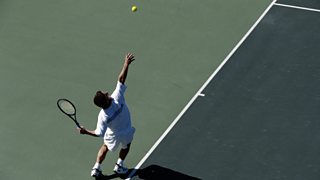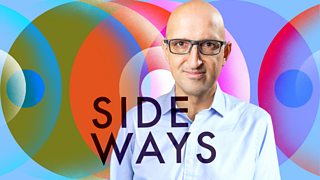The art of deception in sport
In sport there is cheating and then there is deception. Deception and psychological skulduggery are within the rules and part of the game, and they're what you do to win points of score goals. As Matthew Syed discovers in the latest episode of Sideways, fooling your opponents and using their strengths against them is an art form.
Here are six highlights from the programme.
The anti-spinner
In 1980, underdog English table tennis player John Hilton stunned audiences with his style of play, effortlessly confounding talented European opponents.

Agassi worked out that Becker would stick his tongue in the direction of where the serve would go.
He started his career as a below average table tennis player in Manchester but a move to Australia connected him with Paul Pinkewich, the Australian number one. He gave Hilton some advice that would change the direction of the table tennis ball and, therefore, Hilton’s career. What Pinkewich did was to suggest that Hilton use a bat with one side covered in the normal grippy surface for spin and anti-spin rubber on the other side with no spin at all. Each side was the same colour, Hilton would twiddle his new bat one way and the other, so the opposing player didn’t know what shot was coming their way. He was practising the art of deception at the highest level.
The ploy was controversial, eventually being banned, and it helped Hilton win the 1980 European Table Tennis Championships.
The tongue-tell
With so little time to react to situations, athletes are reliant on early cues to inform them what they’ll do. For example, Boris Becker’s serve was widely regarded as his most devastating weapon, but rival tennis star Andre Agassi found a way to decode it.
After watching videos of Becker’s game, Agassi worked out that Becker would stick his tongue in the direction of where the serve would go. “It would either be right in the middle of his lip or would be to the left corner of his lip,” recalls Agassi.
Despite the decoding, Agassi also had to practise a strategic deception. He realised that if he moved in the right direction every time Becker would realise that he had been rumbled. “I had to resist the temptation of reading his serve for the majority of the match and choose the moment when I was going to use that information.”

Covert operations
Masking your intention is a key element of the sportsperson’s toolkit. Crystal Palace goalkeeper Chloe Morgan describes the jeopardy she faces, with just milliseconds to work out what the opposing attacking player will do to wrong-foot her. “We end up looking silly, rolling on the floor with a dive to the right and the ball ends up in the top-left hand corner.”
Data-led preparation was a key factor in England’s 2018 World Cup penalty shoot-out success in 2018.
In order to mitigate that, Morgan describes the mental process she goes through. “There's an abundance of factors: the pitch conditions, the striker themselves, the position of your defenders, where you are in the goal, what kind of strike it's likely to be. You sort of look at the position of their foot, their approach.”
Data-driven decisions
While some of the factors outlined above have to be assessed quickly, sportspeople like Morgan have plenty of data to look at before the game.
Use of data in sport was pioneered in the 1950s by former accountant, RAF wing commander and ardent Swindon Town football fan Charles Reep. His number crunching showed the contrast between ball possession (an average of 250 times for each team in a game) and goals scored (just a couple a game). His findings led to the "long-ball" or more direct style of football, where the ball was launched into the opposing half at the earliest opportunity. Not pretty to watch but effective until it fell out of fashion in the top flight.
Use of data in sport is now known as "performance analysis" and is a huge industry. It seeks to understand the opponent and also to use that information to deceive/foil them. For example, data-led preparation was a key factor in England’s 2018 World Cup penalty shoot-out success in 2018, helping Jordan Pickford make crucial saves.
Blind spots
Data is useful, but too much information on form can lead to over-confidence and actually be counter-productive.

Dr Maria Konnikova, journalist and author of The Confidence Game, describes this phenomenon as the knowledge-ignorance paradox.
One example of this comes from the financial world where professional, expert investors are the most susceptible to cons. The sporting equivalent is knowing the percentage likelihood of a rugby player to dummy on one side or another. Knowing that percentage will dictate the opposing players’ actions and potentially build in a "blind spot" to a different pattern of behaviour.
A strange kind of empathy
Whether it’s customisation, observational powers or data-driven research, the point of deception in sport is to gain the upper hand. The first step in deception is to understand what your opponent is about and then what would vex them the most.
Matthew Syed contends that John Hilton knew that “the highest form of deception relied, in a strange way, upon empathy” and that he was “deeply attuned to his opponents”, adding that “he always calibrated his approach to maximise their discomfort.”
Listen to Sideways: Fooling the Opposition
More from �鶹�� Radio 4
-
![]()
Sideways: Best Feet Forward
Matthew Syed reveals how teams can become greater than their individual parts.
-
![]()
Thought Cages: The Art of Self-Deception
Rory Sutherland investigates how we have evolved to deceive ourselves… in order to better fool others.
-
![]()
Costing the Earth: Sustainable Sport for the Future
Can world sporting tournaments really be sustainable? Qasa Alom finds out.
-
![]()
Sideways: Mental Athletics
Matthew Syed asks whether anyone can become a mental athlete with a few simple brain-training techniques.



